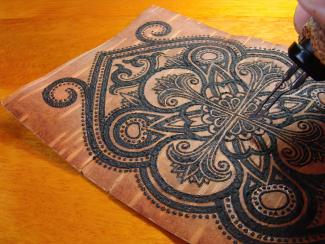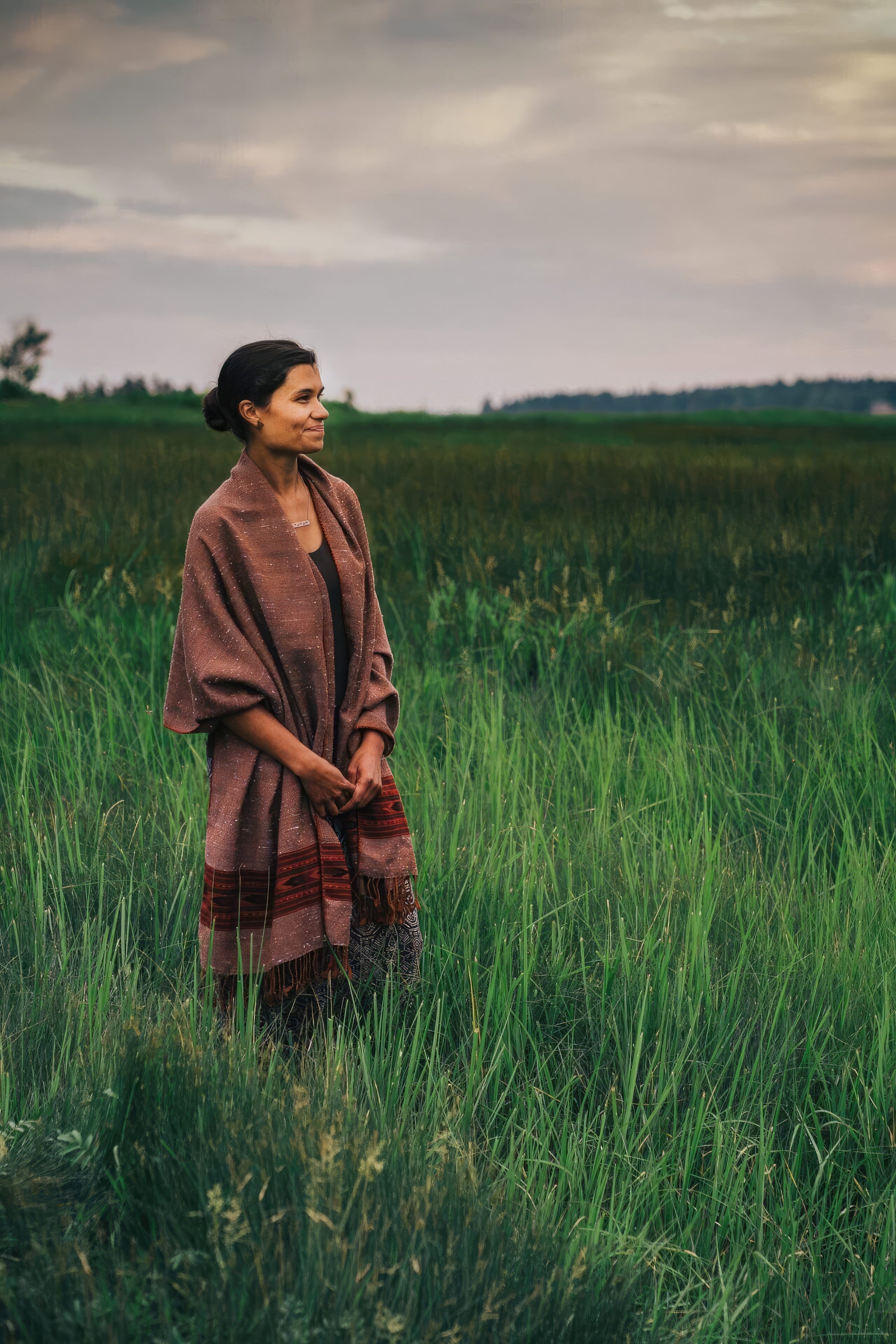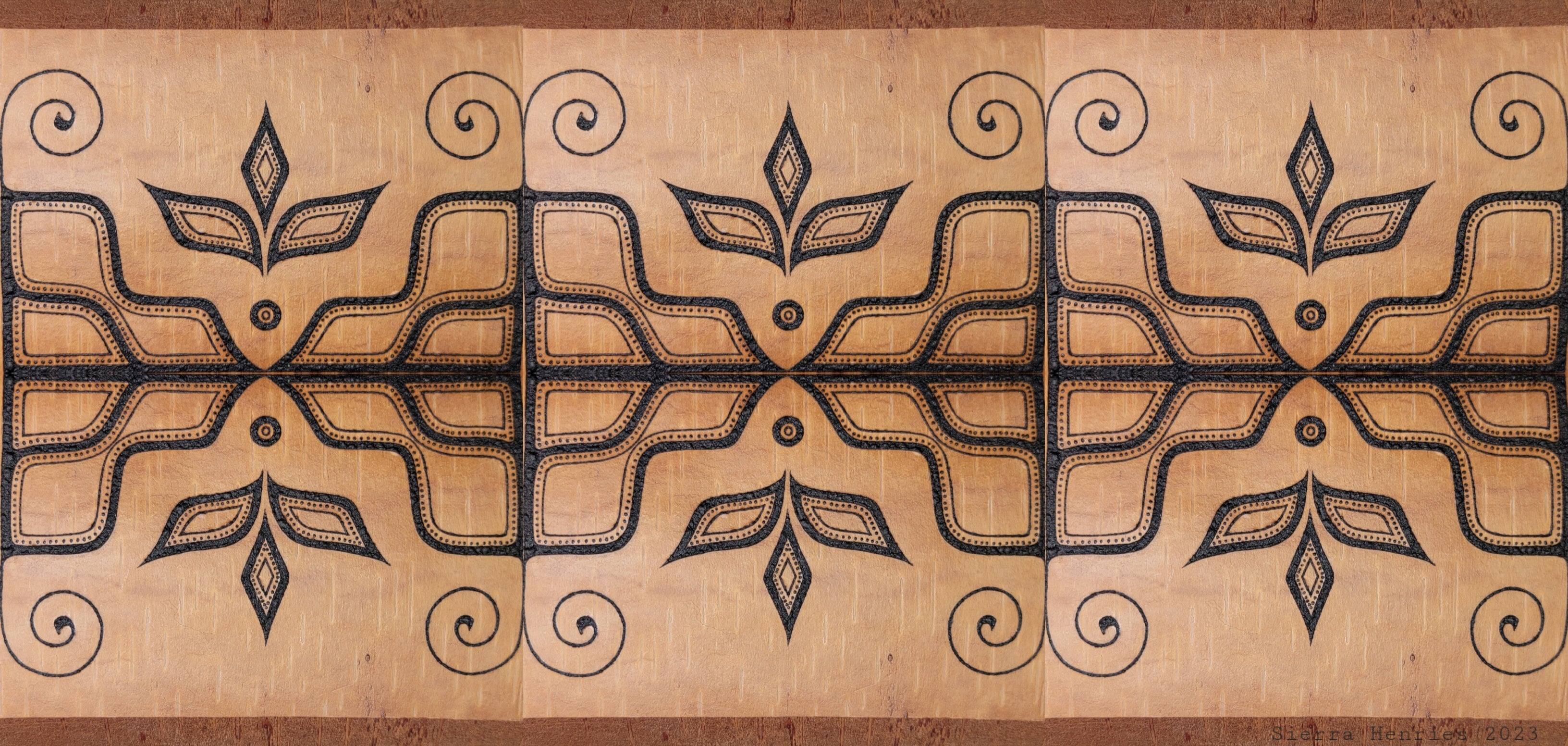
Sullivan, Maine-based artist Sierra Henries (Chaubunagungamaug Band of Nipmuc) credits her talented mother, Lisa, and father, flutist Hawk Henries, for inspiring her to dabble in all types of art styles and mediums from a young age. Now, she specializes in birch bark pyrography. “The pyrography or woodburning tool is something I started using very early on, working with materials such as wood and gourds for some time. One day, through an idea offered by my mom, I tried burning on birch bark. This bark is a material that has been, and continues to be, used by Indigenous people in the Northern regions around the world. Here in the Northeast, you will see it beautifully decorated through an etching technique, or stitched together into a basket, or painstakingly fashioned into a canoe. Needless to say, I’ve continued to create pyrography artworks on birch bark for over 16 years now,” Henries says.
Henries describes her process for creating her artwork: “I begin by sketching my design in pencil on the bark. Then, I utilize an x-acto knife for any cutting work involved. Lastly, I burn the design with the pyrography tool. All the work is done freehand; no rulers or stencils are used.” She adds, “There are other steps to the process that are important to acknowledge, like how sometimes friends and other birch bark artists will gift me bark and tell me stories of the trees it came from, or the projects they were working on with it, and those stories help nourish my art. It’s important to gather the bark in a certain way so that the tree is not harmed.” Though she derives inspiration from many sources, Henries says, “I often find myself just sitting with the piece of bark and letting the lines of what will become show themselves. The bark oftentimes has stories of its own that I could not have thought of or predicted. I try my best to allow space for that offering and then see where it takes me.”

Sierra Henries stands in a field of Sweetgrass. Photo by Ta Moko Ormsby.
Henries has worked with a variety of universities, museums, and art events from New England to Louisiana, including Yale Peabody Museum, Roger Williams University, and the Cultural Survival Bazaars. She is currently participating in an exhibit called “Boundless,” hosted by the Mead Museum in Amherst, which opens September 14 and runs through July 7, 2024. Henries sees her artwork as a way to counteract the persistent misinformation about Indigenous Peoples. “There is a genuine lack of knowledge that persists in our society, and it often manifests in misrepresentation and appropriation of Indigenous cultures and artforms,” she says. “The privatization of lands and laws surrounding places like national parks has meant that there is a direct cutoff from the materials I use in my work. Individuals such as Suzanne Greenlaw (Maliseet) have been doing amazing work to regain cultural access to spaces like national parks and allow for the gathering of traditional medicines and materials.

Digital mirroring of double curve design. Photo by Sierra Henries.
Similarly, Hawk utilizes his flute music and passion for dialogue to create welcoming and engaging spaces for people to ask questions and learn. Bridge building opportunities such as these feel vitally important to me as a way to mend the impacts of ignorance.” On participating in the Cultural Survival Bazaars, Henries says, “The Bazaars have been some of my favorite events to attend. My family and I have participated for over 15 years. Fellow vendors have become more like family than friends. The Bazaars offer the opportunity for Indigenous art to be recognized as deeply valuable to both the local and broader communities, and for attendees to better educate themselves on the importance of Indigenous people maintaining their cultural practices. They also create the space for the public to support artists directly through sales, which helps our businesses to thrive.” She continues, “What nourishes me, what fills my well of inspiration, it’s the moments where a dear friend wants to get one of the designs I’ve created as a tattoo when an Indigenous community organization uses my work as their logo . . . the moments when my art and the people I love connect are my greatest accomplishments.”
Learn more about Sierra Henries’ work at www.sierrahenries.com.
The Cultural Survival Bazaars Are Back! December 14-17, 2023 The Prudential Center, Boston, MA.
Learn more at bazaar.cs.org
Top photo: Birch bark art by Sierra Henries. Photo courtesy of Sierra Henries.
